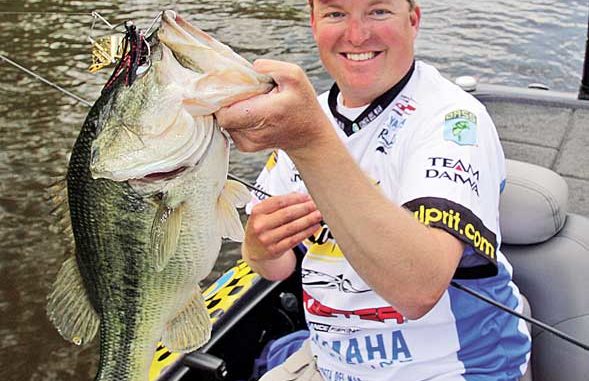
Fishermen are so good these days, it’s harder every year to stay competitive. One thing I always look for especially in tournaments, is where the fish are going to go — not where are they now, but where will they be a few days from now. Being the first to discover a pattern is like having the lake to yourself. June comes to mind as a good transition month because so many fish are finally showing up on structure. Be the first to that structure and you can have awesome fishing. I normally start checking some outside structure in May if there’s an early spawn.
It doesn’t take long to know if the fish are there. The first ones to arrive on a new place are the easiest. I think that’s because they’re not totally in tune with their new area and make more mistakes. It also could be that they are hungry after the spawn — or both.
After a while, bass become conditioned, and it’s time to move on or switch tactics. One of my favorite non-traditional tactics has become throwing swimbaits on a jighead to deeper fish. I use Culprit’s Ultimate Minnow, which is similar to the Basstrix-style baits. This gives you total depth control and a realistic action. The bottom must be relatively clean or the bait’s exposed hook will snag. If there’s a lot of cover, I’ll try to fish it just above the cover a little faster or Texas-rig it. I throw this bait on a 7-foot-1 heavy-action Daiwa Steez rod and 7.1-to-1 Steez reel.
If you’re practicing for a tournament and find them really stacked up on a ledge, it pays to check the surrounding areas in case they’re gone when you arrive. I keep an open eye to everything around, even the bank. If the lake level rises or there is no current, they may just have moved up on the bank or to nearby docks.
Check everything from points to road beds. If they’ve moved to something new, they’ll be easy to catch if you can find them — but finding them is the hard part. Keep the time of day in mind, too. Often, the fishing is not that great early in the morning, but they get cranked up as the sun gets the whole food chain going.
Check a good spot several times a day, but be careful not to waste too much time checking any one spot. You want to hit it good, but don’t “rot” on it. Ten to 15 minutes should be sufficient to know if they’re going to bite. If you know fish are there, triggering that first strike could get the whole school going, so trying a good spot from different angles at different times of the day could work.
Checking the weather frequently is important as well. If the wind is going to change direction throughout the course of a tournament, it would be wise to check some places that may be less than ideal for the current conditions. Knowing about potential places before a weather change saves you big time when the tournament begins. If it’s cloudy during practice and the sun is going to shine, the fish will get tighter to cover so prepare accordingly.
Wherever and whenever you fish, keep an open mind about where the bass will move, and you should get faster, better results. There is nothing relaxing about fishing.



Be the first to comment